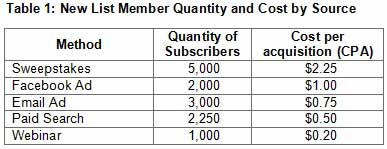I was paid $16.56 for my email address. You read that right: CVS, the drug and pharmacy chain, paid me that much to acquire my email address.
There I was, in my local store, buying about $40 worth of health and personal-care items, when the clerk offered me an instant 20% savings on my purchase in exchange for my email address. So I gave it to her to receive a discount of $8.28, which somehow (likely by mistake) was applied twice for a total savings to me (and cost to CVS) of $16.56.
At two recent business events (which did not provide exhibitors and sponsors with attendee lists), I noticed that exhibitors were actually paying attendees cold hard cash in exchange for their email addresses. Yes, they were handing out the green stuff in a blatant, unmasked exchange for data.
One business coach offered passersby $1 for a name and email address, and $5 for a completed lead-qualification questionnaire. At another event, an exhibiting sponsor held a stack of crisp, fresh dollar bills and asked all visitors whether they would like $1 in exchange for their email address. Most attendees cruising the exhibits at these events happily gave up their email addresses and took the money.
Compared with a dollar, $16.56 might seem like a pretty hefty price to pay for an email address, but we would do well to reserve judgment, remembering that the value of an email (or any marketing list) subscriber is entirely relative to the value that the average subscriber brings to your business over the course of a year. And not just over the course of a year... but over the course of their entire customer lifetime with you.
So how do you determine the value of new subscriber as well as the limits of what you'd be willing to pay to get one?
With upward pressure to reach new markets, compensate for list attrition, and reach current customers in new channels (like mobile), the importance of not simply maintaining but expanding your digital marketing lists cannot be overestimated.
In this two-part series, I'll explain two critical measures to include in your key marketing performance indicators and thoughts on how to determine each. This month we'll begin with CPA (cost per acquisition); next month we'll explore RPS (revenue per subscriber) as a way to assign an average economic value to each subscriber on your list.
Whether you are acquiring email, mobile, telemarketing or direct mail list subscribers, the following logic applies. You simply must know your maximum cost threshold for getting a new subscriber; otherwise, you're spending in the dark—or, worse yet, to the point of negative returns.
CPA (Cost per Acquisition)
Discovering your cost to obtain a new list member is the only financially sound way to determining how much you can afford to invest in proactively growing your list and what your maximum allowable cost to obtain a new sign-up should be.
Ideally, your list sign-up CPA will be well under your average sale amount from a new customer and within range of what you pay to obtain other valuable actions, such as webinar sign-ups, free content downloads, or even direct sales.
There are many methods for obtaining new email list subscribers. The reality that most marketing gurus like to gloss over is that all list-growth methods have a cost. They'll either cost you time or money, or both, but—make no mistake—there is no free way to an instantly massive email list.
Let's consider some of the more common email list growth activities:
- Paid digital efforts, like Facebook or Google ads, direct responders to a "lead magnet" or free content download form where you collect new lead/list member data, but those ads don't come for free. You can buy paid search marketing to boost your rankings—again at a monetary cost. Or, you can place paid ads in other companies' e-newsletters or rent their email lists. Each of these tactics is an investment in both time and money.
- Events—live, virtual, or both—are another proven channel for list growth, albeit one of the most expensive. However, they provide a more in-depth connection to your company, product, or service and therefore accelerate the conversion process, which is why many event leads convert at a higher rate.
- Then there are the joint venture and affiliate marketing opportunities. A company or brand already reaching your target market promotes your products/services to its list and its subscribers end up also subscribing to your list. Orchestrating and maintaining a successful affiliate program tends to cost more in time than money, and affiliates deliver with varying degrees of success.
- Finally, there are the specific promotional strategies you can employ on your own site, like pop-up light-boxes offering exclusivity, savings, etc., as well as sweepstakes or contests, but they'll take time and a developer to execute, although they can generate rapid and voluminous list growth.
Here's the good news: By allocating a small percentage of your total list growth budget to test a variety of list-building methods and calculating what it actually costs you to get a new subscriber from each, you'll determine which methods deliver the best quantity of new list members, which deliver the best quality, and which deliver both quantity and quality.
As you acquire new subscribers during your test period, rank each acquisition method by both quantity and cost as follows:

Next, determine your maximum allowable CPA for acquiring a new list member, and continue to invest in the methods that fall at or below your max CPA.
For example, a marketer who tested the above tactics might decide that the maximum allowable CPA for a new email address is $1.00, and so would pursue all methods costing $1.00 or less.
Finally, over time (once every six months or at least once per year) also measure the quality of names on your list by monitoring conversion rates, average order/sale value, and unsubscribe rate, as follows:

When you compare the two tables, you'll easily be able to spot the methods that produce both the desired quality and quantity of subscribers within your allowable CPA. In fact, the higher the quality of subscribers you attract, the more likely they are to convert to becoming not only customers but also your best customers—resulting in more revenue from which to raise your CPA.
In Table 2, although sweepstakes produced a high quantity of new list members, those who registered were more interested in winning a prize than in genuinely being on the list or eventually becoming customers, so list churn was high and average order value was low. On the other hand, the sweet spot seems to be in using paid search and email ads to obtain new list members in both sufficient quantity and quality.
Regardless of the list subscriber acquisition methods you use, tracking cost and performance by source is a must! Test, measure, and re-evaluate sources if necessary. Know your numbers, establish your maximum allowables, and analyze them to determine your best sources of subscribers and you'll have a road map for cost-effectively growing both prospects and customers over time.
Next month, we'll continue with RPS (revenue per subscriber), a way to measure the economic value of each list subscriber and, as a result, the value that particular subscriber-based marketing channels like email or mobile (SMS) marketing are delivering as a whole.
Until then, I'd love to know which list growth methods you're having the most success with, as well as where you struggle or need help.




